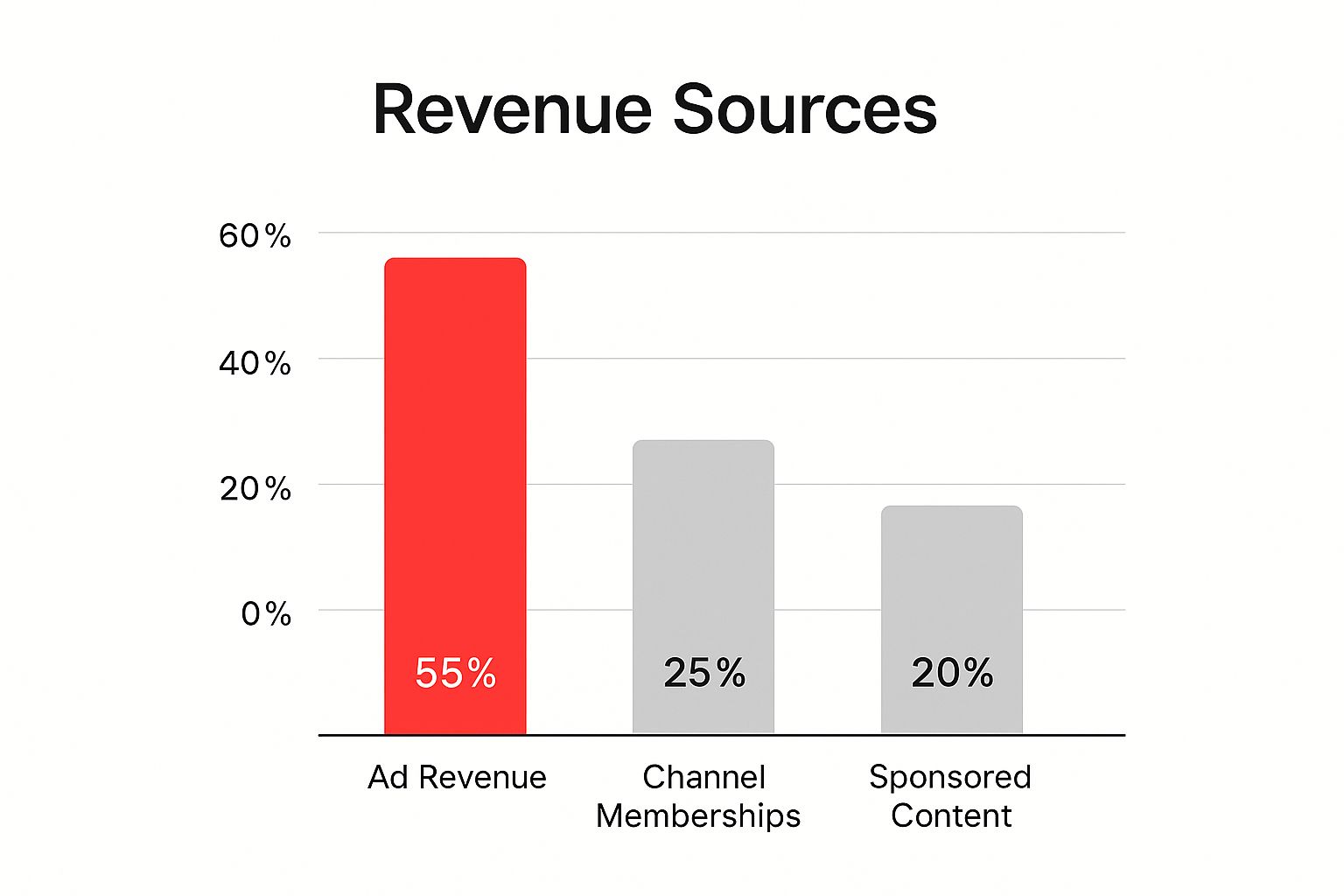The Reality Behind YouTube Earnings (What Creators Won't Tell You)

Let's be real, the YouTube dream isn't all Lamborghinis and private jets. You see the flashy lifestyle some creators portray, but what you don't see is the hustle behind the scenes. I've spent a lot of time digging into creator revenue reports and chatting with YouTubers of all sizes, and here's the inside scoop: subscriber counts can be incredibly misleading. Two channels with identical subscriber numbers can have vastly different incomes.
Why? Because your audience and what you create matters big time.
For example, imagine a gaming channel with 100,000 subscribers. It might be bringing in significantly less cash than a finance channel with the same following. This all boils down to audience demographics and niche. Advertisers shell out more for certain audiences, and some niches just naturally attract higher-paying ads. This is where CPM, or Cost Per Mille (cost per 1,000 views), comes into play.
In high-value niches like finance, you might see CPMs of $15-20, while gaming channels often average $3-5. That difference adds up fast as your views climb.
Understanding the YouTube Money Game
So, if subscriber count isn't the key, what is? It's all about your RPM, or Revenue Per Mille. This is the real money maker – the amount you actually earn after YouTube takes its cut. And remember that YouTube/creator split? It's 55/45 in YouTube's favor. So, even with a great CPM, your RPM will be lower. Plus, things like ad blockers and skipped ads can chip away at your earnings even more.
Decoding the Revenue Puzzle
Now, you'll hear whispers of YouTube's projected ad revenue surpassing $30 billion globally in 2025. That sounds incredible, right? And it is – for the platform. Individual earnings, however, are a different story. YouTube ad revenue projections for 2025 paint a fascinating picture of the platform's growing power.
Sure, you have outliers like MrBeast, reportedly raking in millions. But for most creators, it's a much smaller piece of the pie. Earnings fluctuate based on niche, audience location, and a bunch of other factors.
This is why understanding the nuances of YouTube revenue is so important. It's not about getting discouraged by the complexities. It's about using that knowledge to your advantage.
To give you a clearer picture of how niche impacts earnings, take a look at this table:
YouTube Revenue by Niche Comparison A breakdown of average CPM rates and earnings potential across different YouTube niches
| Niche | Average CPM | Monthly Views Needed for $5000 | Typical Audience Demographics |
|---|---|---|---|
| Finance | $15-20 | 250,000 - 333,333 | Adults (25-54), higher income, interested in investing, financial planning, etc. |
| Gaming | $3-5 | 1,000,000 - 1,666,667 | Younger demographics (18-34), interested in video games, esports, etc. |
| Beauty | $5-10 | 500,000 - 1,000,000 | Primarily female (18-44), interested in makeup, skincare, hair, etc. |
| Tech | $10-15 | 333,333 - 500,000 | Tech-savvy individuals (18-44), interested in gadgets, software, reviews, etc. |
As you can see, the differences in CPM and required views for a specific income target can be dramatic across various niches. This highlights the importance of choosing a niche strategically, understanding its potential for monetization, and tailoring your content to attract the right audience. Understanding these nuances is the first step to making real money on YouTube.
Understanding CPM vs RPM (The Numbers That Actually Matter)
So, we've covered the basics of YouTube revenue. Now let's get down to the nitty-gritty: the metrics that actually impact your earnings. I've seen so many creators get confused by CPM (Cost Per Mille) and RPM (Revenue Per Mille). Understanding the difference is crucial for calculating your YouTube income accurately.
CPM is what advertisers pay every time their ad is shown 1,000 times. You’ll hear YouTubers talking about their CPM, especially if it’s high. But here's the catch: CPM isn't the whole story. Your RPM is what you actually earn per 1,000 views after YouTube takes its share. And that share is substantial: 45%. This means your RPM is always going to be less than the CPM.
Speaking of boosting your YouTube income, have you thought about going viral? Check out this article on how to make a viral YouTube video. It's packed with helpful tips.
Also, here's a handy chart that visualizes how diversifying your income streams can really help:

Relying only on ad revenue can be limiting. Adding things like channel memberships and sponsored content can really open up new avenues for income. Don't put all your eggs in one basket!
Why RPM Is the Real Metric to Watch
Think of CPM as the sticker price on a car. RPM is the price you actually pay after haggling, taxes, and fees. And just like with car buying, there are hidden factors that can lower your RPM even further, like ad blockers and viewers skipping ads.
Let’s say an advertiser pays a $10 CPM. After YouTube’s 45% cut, your RPM is $5.50. Now, let's be realistic: some viewers use ad blockers or just skip the ads. If 20% of your viewers do this, your effective RPM is actually $4.40. A pretty big difference, right? Speaking of which, you might find this helpful: YouTube monetization requirements.
This is why just looking at CPM can be misleading. You need to focus on maximizing your RPM. This means understanding your audience, their viewing habits, and how that affects ad performance. It's about working smarter, not necessarily harder.
Let’s illustrate this with some real-world examples. The table below shows how different CPMs and viewer behaviors translate into actual earnings.
CPM vs RPM Calculation Examples Real-world examples showing how advertiser CPM translates to creator RPM across different scenarios
| Scenario | Advertiser CPM | Creator RPM | Revenue Split | Actual Earnings per 1000 Views |
|---|---|---|---|---|
| High CPM, Low Ad Block | $12 | $6.60 | 45/55 | $6.60 |
| Average CPM, Moderate Ad Block | $7 | $3.85 | 45/55 | $3.08 (assuming 20% ad block) |
| Low CPM, High Ad Block | $3 | $1.65 | 45/55 | $0.88 (assuming 60% ad block) |
As you can see, even with a high CPM, your actual take-home can vary significantly. By grasping the relationship between CPM and RPM, and what influences them both, you can make better decisions about your content and how you monetize it. This is essential for accurately estimating your earnings and setting realistic income goals.
Why Your Audience Location Can Make or Break Your Income

Here’s the thing about YouTube revenue: your audience's location really matters. I've seen firsthand how the same video can earn vastly different amounts depending on where the views are coming from. We're talking a potential 10x difference.
Imagine this: your awesome tech review gets 100,000 views. With a US-based audience, you might be looking at $1,800. Not bad, right? But if that same video racks up those views from an audience in a different region, you might only earn $180. Ouch.
It’s not about viewers being more or less engaged in certain countries. It boils down to how much advertisers are willing to pay. They'll shell out more for viewers in wealthier countries because of higher purchasing power.
Understanding the Geographic Divide
So, even with killer content that resonates globally, your earning potential is tied to your audience's location. This is why you need to know where your viewers are coming from. Are most of your views from the US, Canada, or the UK? Or from regions with lower CPMs (Cost Per Mille)? This is crucial for accurately calculating your potential earnings.
Think about massive channels like T-Series and Cocomelon. In 2025, T-Series had over 290 billion lifetime views and 290 million subscribers. Cocomelon wasn't far behind with 198 billion views and 191 million subscribers. Crazy numbers, right? But even for these giants, audience location impacts their bottom line. Check out some interesting creator stats.
CPMs can be over $20 in some countries, but less than $5 in others. That means a video with 10 million views could earn $200,000 in the US (at a $20 CPM) but less than $50,000 elsewhere. Big difference!
Maximizing Your Earning Potential
Now, this doesn’t mean you should ignore your international audience. Absolutely not! Instead, use this knowledge to your advantage. Think about targeting higher-paying regions with specific content or promotions without changing your core message.
For example, offering subtitles in multiple languages can expand your reach in lucrative markets. Or, tailor examples within your videos to resonate with different cultures. It's all about maximizing your earning potential without losing your authenticity. Knowing your audience's location is key to turning views into dollars.
Mining YouTube Analytics for Accurate Revenue Predictions
Your YouTube Studio is a goldmine of information. But knowing which nuggets to dig for is the key to accurately predicting your YouTube income. I'll walk you through some real-world analytics, showing you the metrics that actually matter. Forget vanity metrics—we're focusing on the stuff that pays the bills.
This screenshot shows a typical YouTube Studio Revenue page, highlighting important metrics like RPM, estimated revenue, and views. See how the RPM jumps around? That's ad performance changing day by day. Tracking these changes over time helps you see the bigger picture of your earnings.
Deciphering Watch Time and Retention
Watch time isn't just about accumulating hours; it directly impacts your ad revenue. Longer watch times tell YouTube your content is engaging, which can boost your CPM (Cost Per Mille). Higher CPM means more money for you. Audience retention is also key. It shows you where viewers are clicking away. If people are bouncing early, maybe your intros are too long, or the content isn't what they expected.
Engagement Metrics: Beyond Likes and Comments
Likes and comments are great, but they don't tell the whole story. Clicks on cards and end screens, playlist adds, and shares—these are the metrics that show real engagement. They tell you your audience is taking action, which often means higher revenue. Think about it: if viewers are clicking through to your merch page, they're more likely to buy something.
Tracking RPM Trends Over Time
Your RPM is the single most important number in YouTube analytics. It’s the actual amount you earn per 1,000 views. Don't just look at it—track it. Look for trends and find your highest-earning content. Do your tutorials make more RPM than your vlogs? This type of analysis helps shape your future content strategy.
Identifying Seasonal Patterns
Just like any business, your YouTube income might change with the seasons. Maybe you see spikes during the holidays or dips in the summer. Understanding these trends helps you plan your content calendar and budget wisely. For example, a consistent summer slump might mean it's time to explore other income streams, like affiliate marketing or selling merchandise.
There are also some fantastic third-party tools and calculators that can automate your income projections. These tools can be a real game-changer, helping you make data-driven decisions about your content, saving you time, and maximizing your earning potential. If you're serious about treating your YouTube channel like a business, they're worth checking out. By really diving into your analytics and using those insights, you can transform your channel into a well-oiled, money-making machine.
Real Income Calculations: From Theory to Your Bank Account

Okay, let's get down to brass tacks. We've covered CPMs, RPMs, and the impact of audience location. But how do these metrics translate to actual money hitting your bank account? Time for some real-world examples!
From $100 to $1,000: Mapping Your Income Journey
That first $100 earned on YouTube? It's a fantastic feeling, a real validation of your efforts. Let's imagine your RPM is $5. To reach that $100 benchmark, you'll need 20,000 views. Not too daunting, right? But what about scaling up to $1,000 per month? With that same $5 RPM, you’re looking at 200,000 views. This is where smart content strategy and audience growth become absolutely critical.
Case Studies: Real Creators, Real Earnings
I’ve seen channels pulling in $500, $5,000, and even $50,000 a month. One key takeaway? Income diversification. While ad revenue is often the core, savvy creators don’t stop there. They explore sponsorships, merchandise, and affiliate marketing to bolster their earnings. This creates a safety net when ad revenue fluctuates, whether it's due to seasonal ad spending dips or algorithm tweaks.
View Count Requirements: The Path to Full-Time Income
How many views do you need for a full-time income from YouTube? It's a question with no single answer. Your niche, audience location, and of course, your ad rates all play a role. Let’s say your goal is $4,000 a month. With a $2 RPM, you'll need 2 million views. However, a $10 RPM brings that down to 400,000 views. This highlights the power of choosing a profitable niche. For more on the view-to-earnings relationship, check out this article on viewership requirements. It’s another reminder of why diversification is so important. Relying solely on ad revenue can be a risky game.
Projecting Growth: The Math Behind Success
Knowing how to project your channel's growth is just as crucial as understanding your current income. Lots of creators use simple formulas for this. Imagine your channel is growing at a steady 10% each month. If you're currently earning $1,000, you could realistically project $1,100 in earnings the following month. It’s basic math, but it allows you to set attainable goals and monitor your progress. Building a successful YouTube channel is a marathon, not a sprint. Understanding the numbers, and using them strategically, is key to transforming your passion into a sustainable career.
Calculating Beyond Ads: Your Complete Revenue Picture
Let's be honest, relying solely on ad revenue on YouTube is leaving a lot of potential income on the table. It's like relying on just one crop when you have a whole farm available! Savvy creators understand that true financial success on the platform comes from diversifying their revenue streams. Think sponsorships, affiliate marketing, merchandise, channel memberships, and even Super Chat donations – these can significantly boost your earnings.
Beyond Ad Revenue: Exploring Multiple Income Streams
I've witnessed firsthand how creators have absolutely skyrocketed their income by building multiple revenue streams. For example, a gaming channel I follow, with around 500,000 subscribers, actually makes more money from merch and sponsorships than they do from ads! This isn't some secret formula, it's about understanding your audience's value and tapping into it effectively.
If your viewers are engaged with your content, they're likely open to supporting you in other ways. Think about it: if they love your gaming tutorials, they might be thrilled to sport a t-shirt with your logo or pick up the same gear you use through an affiliate link. These avenues can easily triple, or even ten times your YouTube income beyond ad revenue alone.
Pricing Sponsorships Strategically
A common misconception is that sponsorship pricing is a simple "$1 per 1,000 subscribers" equation. Trust me, it’s way more nuanced than that. It’s all about the value you bring to the sponsor. What’s your audience engagement like? Do you have a niche audience that advertisers are clamoring for? A highly engaged audience of 50,000 can be far more valuable to a sponsor than a passive audience of 200,000. Know your worth and don't sell yourself short!
Affiliate Marketing: Unlocking Hidden Potential
Affiliate marketing, where you earn a commission for promoting products or services you genuinely use and believe in, is a powerful tool for boosting your YouTube income. Imagine you recommend an editing software in your tutorials. With a 5% commission on a $200 product, you’d earn $10 per sale. If just 100 viewers purchase through your affiliate link, that's an extra $1,000 in your pocket. Not bad at all!
Merchandise, Memberships, and More: Diversifying Your Earnings
Merchandise, like t-shirts, mugs, or stickers, can be a goldmine if you’ve cultivated a strong brand and a dedicated community. Channel memberships offer exclusive perks to subscribers, creating a steady, recurring revenue stream. And don't forget about Super Chats and donations, which can add up surprisingly fast, especially during live streams.
Finding the Right Mix for Your Channel
The ideal combination of revenue streams will vary depending on factors like your audience size, engagement level, and niche. A smaller, highly engaged audience might thrive with memberships and merchandise, while a larger channel might focus on a mix of ads and affiliate marketing. The key is to experiment! See what resonates best with your audience and refine your strategy along the way. Ready to supercharge your channel monetization? Explore our range of monetized accounts at MonetizedProfiles. Building a robust income strategy is essential for long-term success on YouTube, allowing you to thrive even when the ad landscape fluctuates.
Your Complete YouTube Income Calculation System
So, you’re curious about how to really calculate your YouTube income? You’ve heard about CPM and RPM, audience location, and diversifying your revenue streams. Now, let’s piece it all together into a system you can actually use to not only understand your current earnings but also plan for future growth. Forget complex spreadsheets and expensive software; this is all about practical tools and actionable insights from someone who’s been there.
Building Your Personalized Income Tracker
I always recommend starting with a simple spreadsheet. Nothing fancy, just a place to track your key metrics. I like to include columns for estimated RPM, projected views, ad revenue, sponsorship income, affiliate earnings… basically anything that contributes to your bottom line. This gives you a bird's-eye view of your total YouTube income potential.
Speaking of which, when you start calculating income beyond just ads, understanding video compression becomes really important. Good compression means better video quality and faster upload times, which can indirectly impact your income. I found this resource on Video compression for YouTube/TikTok incredibly helpful.
Here’s a simple example of what your tracker might look like:
| Month | Projected Views | Estimated RPM | Ad Revenue | Sponsorships | Affiliate Earnings | Total Income |
|---|---|---|---|---|---|---|
| January | 100,000 | $5 | $500 | $200 | $100 | $800 |
| February | 120,000 | $5.50 | $660 | $250 | $120 | $1030 |
| March | 144,000 | $6 | $864 | $300 | $144 | $1308 |
This kind of tracking system keeps you organized, helps you set realistic income goals, and lets you celebrate those milestones as you hit them! You can also check out the YouTube monetization guidelines for some extra tips.
Spotting Red Flags in Your Analytics
YouTube Studio is your best friend for income calculations. But knowing what to look for is key. Keep a close eye on your RPM trends. A sudden or consistent drop isn’t necessarily cause for panic, but it is a signal to investigate. Is it a change in ad performance? A shift in audience behavior? It might be time to refresh your content or find new ways to engage your viewers.
Watch time and audience retention are also critical. If viewers are clicking away early, it’s a strong hint that your content isn’t resonating as well as it could be. Don't take it personally! Use this valuable feedback to improve your videos and keep people hooked.
Avoiding Common Calculation Mistakes
Over the years, I've seen creators make a few common mistakes when calculating their YouTube income. One of the biggest is mixing up CPM and RPM. Remember, CPM is what advertisers pay, while RPM is what you earn after YouTube’s cut. This difference is essential for accurate calculations.
Another mistake? Focusing only on ad revenue. While ads are important, ignoring other income streams like sponsorships and affiliate marketing really limits your earning potential. It’s like putting all your eggs in one basket. Diversification is key to long-term success!
Troubleshooting Your Income Numbers
So, what if your income calculations just don't seem to add up? Don't worry, it happens. First, double-check everything. Are you using the right numbers from YouTube Studio? Look for recent changes on your channel, like new content formats or a shift in your target audience, as these can impact earnings. Still stumped? Reach out to fellow creators or join online communities. Trust me, you're not in this alone! There are tons of resources out there to help you navigate YouTube monetization. If you want a head start, MonetizedProfiles offers monetized accounts that are ready to earn from day one. It’s a solid way to hit the ground running and start generating revenue immediately.








